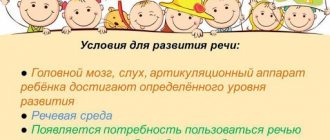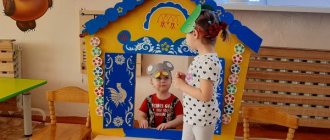Psycho-gymnastics in kindergarten. Card file of exercises part 1
The soul of a child during preschool age is sensitive and vulnerable, so at this time it is most necessary to cherish it, to ensure that the child’s heart, will and mind develop harmoniously.
Emotions are an indicator of the child’s state and mood, his relationship to the world around him and himself, and they themselves significantly influence behavior, mental and motor activity. The smaller the child, the more he is captive of emotions. It is difficult for him to control his feelings and actions, and he is prone to impulsive behavior.
By organizing a child’s life activity in a preschool institution, we create conditions to prevent discomfort and manifestations of his nervousness, discover the causes of emotional experiences and anxiety, and select adequate means of influence.
Emotional discomfort causes certain types of behavior in preschool children :
- Children are unbalanced, excitable, impulsive (annoying emotions often disorganize their activities. In conflict situations with peers, violent affective manifestations are observed: loud crying, uncontrollable movements, outbursts of anger. Negative emotions usually lead to quarrels with other children.)
- Children who are prone to solitude are constrained (a certain complexity leads to low self-esteem, in order to avoid close contacts, slow adaptation to the children's team. Emotional discomfort in these children is caused by self-doubt and reluctance to attend kindergarten).
- Children with various fears (excessive timidity gives rise to constant anxiety. Fear is always a bad helper: it prevents you from correctly assessing the situation, helping a friend in a game or in a real need).
At preschool age, the emotional sphere of the child is unstable. During this period, children begin to differentiate various emotional manifestations and learn to manage their own emotions. In this they are helped by psycho-gymnastic exercises, games, etudes, as methods of non-traditional healing.
The goal of psychogymnastics is to maintain mental health, prevent emotional disorders in a child due to the relief of mental stress, develop a better understanding of oneself and others, and create opportunities for personal self-expression.
Pantomime is expressive movements of the entire human body or its individual parts, body plasticity. Pantomime helps a person to highlight the main thing, to draw an image. Gestures can be descriptive or psychological. The former help the teacher more figuratively interpret the content of what is being presented to the pupils, the latter are aimed at showing the teacher’s internal emotional state, that is, they show his feelings.
Zoo for a walk (3-4 years)
Children move one after another around the hall (preferably accompanied by music) like bear cubs, like bunnies, crocodiles, foals, herons, frogs, foxes. The presenter first shows everyone's move to check, and then can only call it. Draw children's attention to the particularly expressive movements of various animals.
Doctor Aibolit (4-5 years)
Children remember who Aibolit treated (a fox who was bitten by a wasp, a bunny who could not jump, a butterfly with a broken wing, hippos whose tummies hurt). At opposite ends of the hall there are “forest” and “hospital”. All the children walk in a column from the “forest” to the doctor (limping, holding their tummies, moaning, screaming), and from him they return to the forest, jumping merrily and rejoicing at their recovery. The game is repeated three or four times so that each child can play the role of several sick animals.
Travelers (5-6 years old)
Children are divided into pairs. Each couple has one large backpack (bucket, bag, sack). The children decide to take turns carrying it. And so one walks lightly: jumps up, picks flowers, catches butterflies, hums, and the second one hunches over under the burden: barely moves his legs, wipes sweat from his forehead, groans. He is very tired and sits down to rest. The other one immediately notices this, smiles sympathetically, and says: “Now you rest, and I’ll carry it.” He takes the backpack. Game continues.
A teacher or psychologist needs to encourage not only the artistic performance of roles, but also the manifestation of care, compassion for friends, and the desire to help.
Good Witch (5-6 years old)
The Good Witch found out that the Sorcerer had turned good children into evil monsters and decided to go alone into the forest and save them. The monsters wanted to scare her: they shouted in scary voices, threatened with their fists, made faces, showed their teeth, jumped, but she was not afraid of anything. So she chose the moment and touched with her wand one Monster with a hundred arms, a hundred teeth, a hundred voices. It instantly turned into a gentle and cheerful girl. The girl ran up to the sorceress, hugged her, thanked her, and the two of them, holding hands, stood in a circle of terrible monsters.
Suddenly, a three-headed, three-legged Monster approached them and bumped into a stick, skipped a beat and turned into a handsome and brave boy. The girls first took care to make sure they didn’t hurt him, but the boy reassured his rescuers, thanked them for their help, and the three of them continued to save the enchanted children...
The purpose of this game (dramatization of a fairy tale) is to teach kids to express their gratitude, joy, sympathy, care, desire to protect and help each other.
See more exercises here
Psycho-gymnastics in kindergarten. Card index part 2




